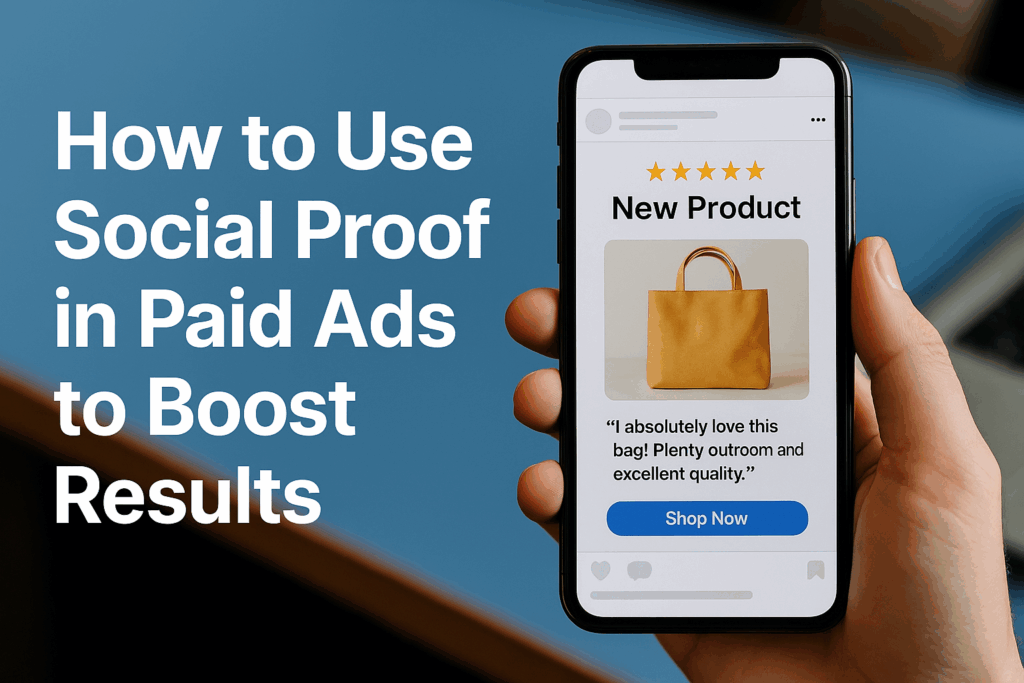Running paid ads without social proof is like selling in a room full of skeptics.
People today are bombarded with ads. They’re cautious. They want to know:
“Can I trust this? Does it really work? Have others tried it?”
That’s where social proof comes in.
Used the right way, social proof turns cold ads into high-performing campaigns by adding credibility, trust, and persuasion—all without sounding salesy.
In this guide, you’ll learn how to add social proof to your ads, where to use it, and what formats work best across platforms like Meta, Google, YouTube, and TikTok.
What Is Social Proof?
Social proof is any form of evidence that other people trust, use, or benefit from what you’re offering.
It tells your audience:
“You’re not alone. Others have been here. It worked for them—and it can work for you too.”
Common types of social proof include:
- Testimonials
- Reviews and ratings
- Client logos
- Case studies
- Before-and-after results
- Number of customers/users
- UGC (user-generated content)
- Influencer endorsements
- Media mentions
Why Social Proof Works in Ads
Because it reduces risk.
People are more likely to click or buy when they see others have done it first—and had a good experience.
Social proof:
- Increases trust
- Reduces hesitation
- Adds emotional weight
- Shows real-world results
- Validates your claims
It helps move people from “Maybe later” to “Okay, let’s try this now.”
Where to Use Social Proof in Your Ads
1. In the Ad Copy
Mention:
- How many people have already bought/downloaded
- Who your clients or users are
- Real quotes from happy customers
Example:
“Trusted by over 3,000 freelancers worldwide.”
“Jessica got 45 leads in 7 days using this exact funnel.”
2. In the Creative (Image or Video)
Include:
- A 5-star review graphic
- Screenshot of a happy customer comment
- Before-and-after visual
- A video testimonial or UGC clip
- “As seen in” logos or press mentions
Platforms like Facebook and Instagram love visual proof—so use it to your advantage.
3. On the Landing Page
Your ad might get the click, but your page closes the deal.
Make sure it includes:
- Verified buyer reviews
- Case study snapshots
- Photos of real customers using the product
- Star ratings
- Testimonials with full names, faces, or companies
Tip: Place one proof element above the fold, so it’s seen instantly.
Types of Social Proof That Work Best in Ads
1. Video Testimonials
Short clips of real people sharing their experience = high authenticity.
Use in:
- Meta Ads
- TikTok Ads
- YouTube pre-roll
- Story placements
Even 15–30 seconds is enough if it’s genuine and specific.
2. Screenshots From Clients or Customers
Examples:
- DMs
- Email replies
- Reviews from platforms (Google, Trustpilot, Etsy)
Add a small caption to give context.
It feels raw, real, and relatable.
3. Case Study Highlights
You don’t need a full PDF. Just summarize it:
“After 30 days with our system, Daniel went from 3 to 15 qualified calls/week. Ad spend: $350. ROI: 4.2x.”
Use this in carousel ads or image posts.
4. Numbers and Metrics
Quantified proof is powerful.
Examples:
- “Over 15,000 downloads”
- “4.8 stars based on 224 reviews”
- “Used by teams at [logos of 3 known brands]”
- “Join 9,000+ email subscribers getting weekly tips”
Make your numbers visible in the headline or creative.
Real Ad Examples Using Social Proof
✅ Example 1 – Meta Ad (Service):
- Visual: Client testimonial video
- Copy: “Meet Camila. She booked 6 high-ticket clients in 21 days using this exact ad strategy.”
- CTA: “Watch how it worked for her.”
✅ Example 2 – Google Ad (E-commerce):
- Headline: “Rated 4.9 by 2,300+ customers”
- Description: “Free shipping + 60-day returns. Over 2,000 5-star reviews.”
✅ Example 3 – TikTok Ad (Course Creator):
- UGC-style video: “I took this course and landed my first client in 10 days!”
- On-screen text: “⭐️⭐️⭐️⭐️⭐️ 1,200+ students already enrolled”
Pro Tips for Using Social Proof in Ads
- Keep it short and visual
- Don’t fake it—authenticity matters
- Use first names and real photos when possible
- Avoid overhyping (“Best ever!”) without proof
- Refresh your social proof often as new reviews come in
If you’re just starting out and don’t have testimonials yet:
- Offer your product/service to 3–5 beta users for free in exchange for feedback
- Ask for voice or video notes
- Screenshot real comments from social media
Final Thoughts: Social Proof Turns Browsers Into Buyers
Social proof doesn’t just add credibility—it removes doubt.
It shows your audience:
- “This is real.”
- “Other people trust it.”
- “You’re not the first—and you won’t regret trying.”
So before you spend more on your next campaign, ask:
“How can I show that this works for real people?”
Because when trust goes up, your CTR, conversions, and results go up too.
